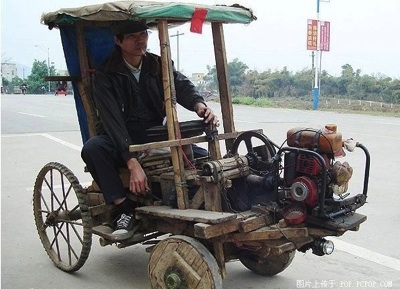This site features the ways in which people modify and re-create technology. Herein a collection of personal modifications, folk innovations, street customization, ad hoc alterations, wear-patterns, home-made versions and indigenous ingenuity. In short -- stuff as it is actually used, and not how its creators planned on it being used. As William Gibson said, "The street finds its own uses for things." I welcome suggestions of links, and contributions from others to include in this compendium. -- KK
Priti Baiks
 Street bikes from Panama. They are called priti baiks. The term priti means both “pretty” and also ingenious, or striking.
Street bikes from Panama. They are called priti baiks. The term priti means both “pretty” and also ingenious, or striking.
The photographs are taken by Jose Castrellon, who spent time hanging around this subculture of hot rodders. Except these guys are too poor to own a car so they soup up their bikes. Note the air horns, normally found on trucks.

His web site says, “Priti Baiks is a series of portraits of men who display tons of creative ingenuity and dedicated a good amount of their meager resources to decorate and equip their humble bicycles.”

Velowalas: Bikes for Business
In much of the developing world, bike technology is significant mobile technology. Bikes are transportation, and offices and shops and stores. The folks at Velowala — velo for “moving” as in velocity and wala for “man” as in the Hindi — collect examples of people using bicycle technology on the streets of India. This wala sells churan, tangy snacks and digestive pills. Many more examples here.

Home-made Camera for Ogling
Nice piece in the New York Times about a Czech photographer who worked in the 60s and 70s using homemade cameras, one of them shown here. They are a wonderful example of street use. The Times said, “he fashioned them from shoeboxes, toilet-paper rolls and plexiglass, polishing the lenses with toothpaste and cigarette ash.” The guy was a bit of a pervert. He took low-res images of pretty girls on the street, in cafes, and on buses. “His photographs may look naïve, but they’re the product of a carefully orchestrated series of missteps that begins with crude, homemade cameras. As he says in the film, “If you want to be famous, you must do something more badly than anybody in the entire world.”” Still, his cameras are cool.

Jailhouse Tech
There’s an emerging category of street technology which might be called Jailhouse Tech. The material constraint of a prison inspire fantastic innovation and re-use of made parts. A lot of the devices made in this manner are crude weapons, but others include eating implements, tattoo instruments, music, and other tools. Here are some examples from a prison in Mexico City by Gabriella Gomez-Mont.

Electric cooking stove made with wire and brick.
From the fantastic interview with the artist who works in this prison and who facilitated the photographer who shot these images:
Now that it is over and done with I can tell you this. For the eight prisoners that helped us it would have easily meant another extra seven years in jail, and for us instant lock-up until they set bail. Especially because of having in our possession—or even presence–those knives made from the metallic edges of the windows! In there, they menace and kill people with those, we would all gotten into so much trouble if we had been caught with them. I don’t even know if those particular knives that we photographed that day had already been used for some sort of bloody business or not, I preferred not to ask; but it would have been even worse.
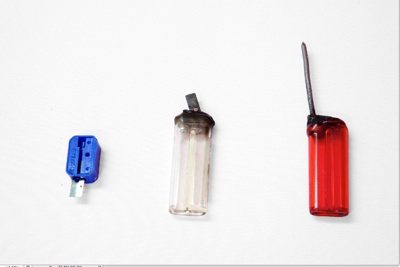
Weapons.
Scooter Contraption
I can’t tell what this is for. Might be a portable night market stall (for food?). There’s a generator on the tail and a light bulb hanging in the middle. Seems to be in Korea. That’s all I know. (Thanks Dave Gray)
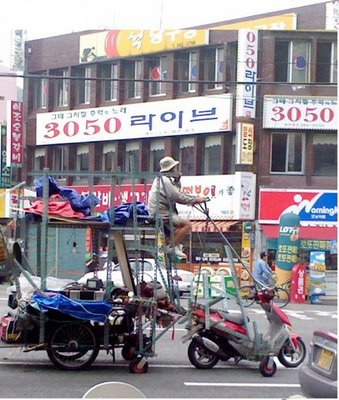
Escape Devices

Photographer Marc Steinmetz features some really cool examples of home-made devices fashioned by prisoners in order to escape. A few of them succeeded.
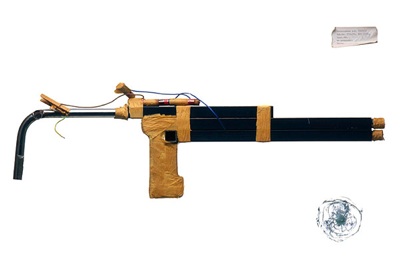
This shotgun was “made from iron bedposts; charge made of pieces of lead from curtain tape and match-heads, to be ignited by AA batteries and a broken light bulb. On May 21, 1984 two inmates of a prison in Celle, Germany, took a jailer as a hostage, showed off their fire power by letting go at a pane of bullet-proof glass [bottom of picture], and escaped by car.”

DOUBLE-BARRELED PISTOL
This gun was found along with other homemade firearms in the cell of two Celle prison inmates on November 15, 1984. The weapons had been made in the prison’s metal workshop. They were loaded with pieces of steel and match-heads.
Street Food Contraptions
Dornbracht, a German manufacturer of bath and kitchen fixtures is presenting a exhibit called “Global Street Food” which has removed street food carts from the streets and spotlighted them in a gallery on Dornbracht’s campus.
I wish I had thought to photograph the many wonderful carts I had seen in my travels, but it never occurred to me then.
Here is grill from Kampala, Uganda.

And a cheese and sausage cart from Buenos Aires.
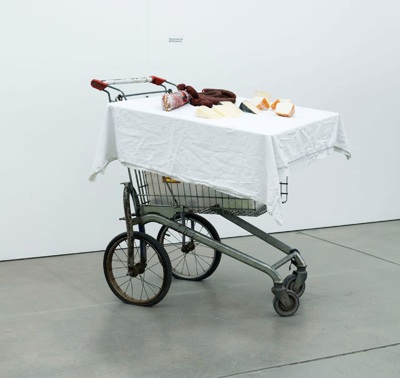
If you have photographs of interesting street food carts send (or point) them to me, and I’ll post.
Clothes Dryer Chicken Coop
Here’s one way to keep your chickens dry. Pete Betchik of Madison on the Lake, Ohio built a chicken shelter using found materials. “The frame is made from wooden pallets, the roof also is pallet wood. The sides are old steel shelves. The inside is lined with old pizza boxes, the nest box was once used to ship fresh fish to market, and the front door was an industrial clothes dryer front.”

Outdoor Barbers in India
Streetside barbers are quite common in India, at least in the smaller towns. A hair cut can certainly wait for good weather. The tools are very portable. Note the cool adjustable head rest on the chairs. This set of pictures comes from Dark Roasted Blend.


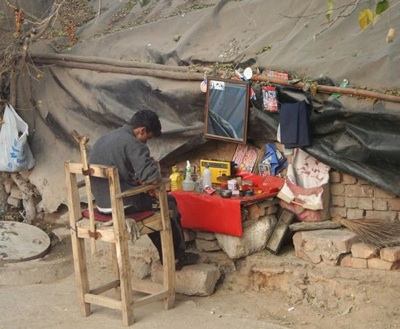
Generator Motor Car
Some kind of home-made vehicle from China. I appreciate the wooden wheels and bamboo combined with what looks like a cheap honda generator motor. (Via here.)
